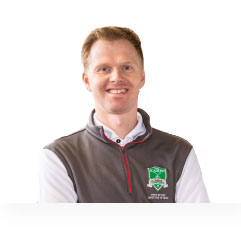 Pete Styles – PGA Teaching Pro
Pete Styles – PGA Teaching Pro
So we've talked a lot in this little series of tips about how the body should be involved, and how it's not just a hands and arms motion but the body needs to be involved. But let's look at specifically what the body's role is, and how the body can get engaged in this process. So we'll start in a good address position, we've just covered that in the previous video. So we're nice and set up to the golf ball. The next stage is going to be activating the body in the first part of the takeaway. So I'm going to use my front shoulder. My shoulder is going to pull around underneath my chin, and as that happens it will just take a little bit of bodyweight to my right side. But it's quite important at this point to note I'm not swaying away from the ball. So it's only five percent extra bodyweight is moving on to my right leg, but I'm turning my shoulders as much as I can until I reach a 90 degree shoulder rotation.
As my shoulders rotate to 90 degrees my hands and arms start moving upwards to the top of the backswing. So it's important to notice again that the hands and arms are involved in the swing, it's not just hands and arms. But it's also not just body, the hands, and arms, and the body, all work together to create the good full backswing. As I've done this my bodyweight has moved to my right side, but it hasn't swayed across. And from this position you should feel quite loaded, quite sort of taut that you've turned the spring. So you've wound the upper and lower body against each other, you've created the power. Now as we start to move into the downswing, the front hip moves across and rotates back. As the font hip moves across and rotates back it's evidence of how the body is creating the power, not the hands and the arms. So it's important from the top, we don't throw the hands and arms at it, but we drive the lower body.
As the lower body pushes off the ground the hip will turn, the chest and the head will turn down to the left-hand side, bodyweight is now moving on to the front leg, then the hands and arms can come through, releasing the club with plenty of power up and out to a nice big wide finish position. Right tiptoe is the only thing on the right side that touches the ground, and all the bodyweight is on the left. And at no point really am I concentrating too heavily on what my hands and arms are doing, it's much more about how my body reacts to generate that powerful golf swing. So focus on how the body turns, the hands and arms will start to play less of a role, and you will reduce your hands and arms reliance.





